Water from the well to the house: how to do it
If you want to improve your life, many people are interested in how to connect water to a house from a well in the garden plot and what is needed for this. At first glance, the system that you see on the diagram may seem very complicated, especially since for submersible pumps, unlike hydrophores, it becomes more complicated, but in practice it turns out, as in the saying where the eye is afraid and the hands are doing.
Below we describe in detail the connection process and preparation for it, and in addition, we will see the thematic video in this article as a supplement.
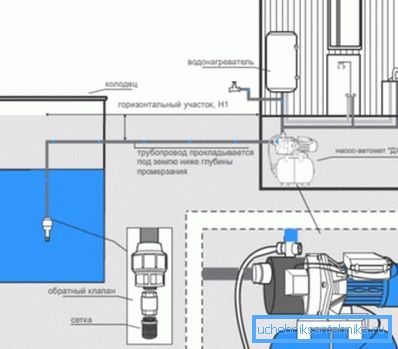
Water in the house
Which pumps are best to use?
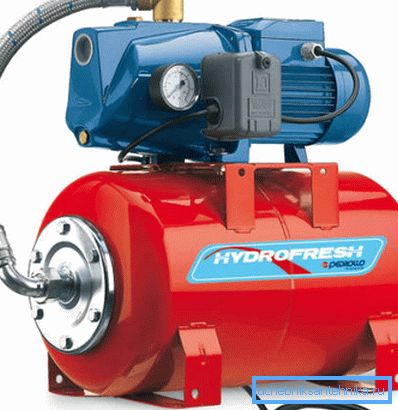
- Perhaps the most popular among ordinary people who do not have sanitary experience is a surface type pump or a hydrophore, which is installed directly in a house or in a utility room. Indeed, the capacity of such a unit is quite sufficient for uninterrupted (if there is a source of electricity) to provide water for a family of 3-5 people and even watering the vegetable garden (depending on the flow rate of the source), moreover, its cost is slightly lower compared to submersible devices. But be that as it may, its capacity is sufficient for water intake from a depth of not more than 9 m, and the wells are not always located on high aquifers.
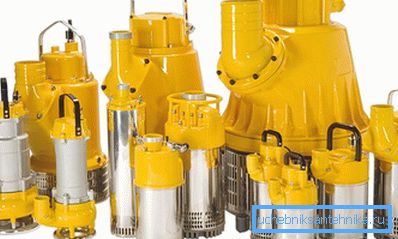
- For wells of any depth, with any dynamic water level, you can use drainage submersible and semi-submersible pumps that are freely included in the operational mine. The advantage of such units is that they can be cleaned, because the number of drainage devices also includes fecal devices, which, thanks to the shredder built into them, can pass through the fallen leaves, and not just silt and sand. The possibility of passing dirty water through these devices is different - it all depends on the wheel, which can be multichannel, single-channel and open, and the ability increases from first to last.
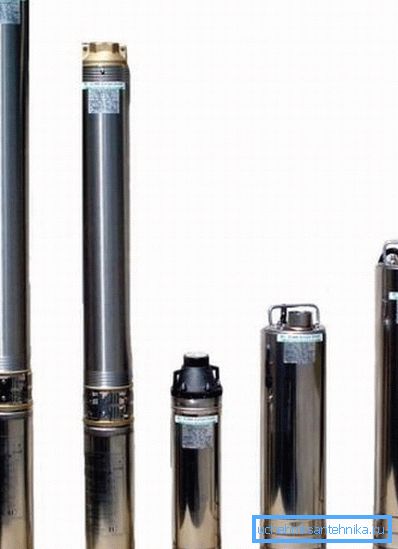
- Such pumps, as in the photo above, are primarily distinguished by a small diameter with a large length (some have more than a meter) so that they can be lowered into a narrow well bore, although they are often used specifically for wells. But such devices can be of two types - screw and centrifugal, and if the former can pass water through themselves with sludge and / or sand, then the latter are not intended for this - there is only a relatively dirty liquid that can pass there. Despite all this, such pumps are also popular, and it is the latter, because for drinking we use only clean wells.
| Bathroom name | Water flow |
| Washbasin taps | 0.4m3/hour |
| Bidet | 0.4m3/hour |
| Toilet | 0.4m3/hour |
| Sink taps | 0.7m3/hour |
| Dishwasher | 0.7m3/hour |
| Washing machine | 0.7m3/hour |
| Shower cabin | 0.7m3/hour |
| Hydrant for watering the garden (garden) | 0.7m3/hour |
| Bath | 1.1m3/hour |
Table of hourly water consumption
Note. One of the important parameters by which a pump is chosen to supply water to a house is not its price, but its power. This indicator you can choose based on the table above.
Assembly work

Let's start with the fact that from the well, to the place where the pumping station will be installed (in the utility room or in the house itself) you need to dig a trench, the depth of which will be below the ground freezing point, as required by the instructions. In addition, you should take into account that there should not be a counter slope in the trench, especially if you use a hydrophore rather than a submersible unit, that is, the slope must be from the station to the well.
In order not to damage the polyethylene hose with any sharp objects (stones, debris) when filling the ditch, you need to pre-arrange the sand pad 2-3 cm, and then, after laying the plumbing, cover it with a layer of sand. The upper layer must be poured 4-5 cm above the level of the pipe and only after tamping these pillows should it be thrown over the ground.
Council In order not to create problems with the tamping of sand, pour back water abundantly with water after filling, and he will pour it over for half an hour.
In laying and backfilling of the trench there is another important point that you should pay attention to - these are the holes that you have to make in the wall of the well ring and foundation. The fact is that if after laying the hose you don’t seal them with cement-sand mortar or tile glue, then the ground water will leak through them, entering the house or well.

We continue to consider how to supply water from the well to the house and now we will examine the features of immersion of a pump or hose with a filter and a check valve from the hydrophore. First of all, you need to consider that with a statistical level of water in the mine from the mirror to the top of the pump or to the check valve, the hydrophore should be at least one meter.
Such a precaution will allow at the dynamic level to remain the suction system in the submerged state - otherwise the engine may fail.
Another point is the charging of a plastic hose through the wall of the ring. In this case, there is a danger of a crease, so even if you pass it through a protecting sleeve (not through concrete), then at the turn you must necessarily embed a corner corner coupling, as seen in the top photo.

When carrying out water from a well to a house is carried out with the help of a submersible pump, the cable length is always insufficient and must be lengthened. To do this, you will need KPBC, KPBP, KPBT or KPBPT cords, you just need to make sure that the cross section of the two pieces coincides.
The twisting is done in one of the ways indicated in the upper figure, at the same time a thermal tube is put on and sealed on each of the veins, and then on the whole coupling - neither water nor frosts are afraid of such insulation.

At the top of the image, you can see the hydrophore wiring diagram, which is quite simple - the main thing is not to confuse anything during assembly, especially when you insert check valves. But here it is important not to miss one thing: the fact is that the water in the house comes from the well only if you fill the accumulator (pear) and the suction hose, otherwise the impeller will just beat the air and the engine will be able to work only idly.
This is especially important in cases when you are not sure that there are no areas with counter slopes on the water intake pipe.
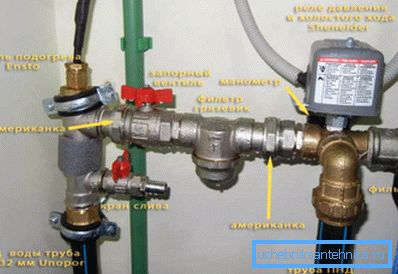
Assembling a submersible pump assembly is somewhat more difficult, but nevertheless it is possible - the connection diagram is attached to each unit by the manufacturer without fail, but here the wiring of water from the well to the house is not related to pouring it into any containers.
Pay attention to the top photo - there you will see that the dry-running sensor and the pressure switch are in the same block, but this is not always the case, and some masters prefer to install them separately, claiming that this increases their service life. In order to reduce the number of automatic starts and stops of the engine, you need to choose a membrane (reserve) tank more, somewhere in the 80-100l.
Conclusion
Most often, the water in the house from the well with their own hands is mounted outside the city, where there may be problems with the constancy of electrical voltage. So that it does not affect the operation of the pumping station, it is connected via a voltage regulator of a certain power, but if such a device stands on the common input, then you will have to take into account all current collectors in the house. Successes!